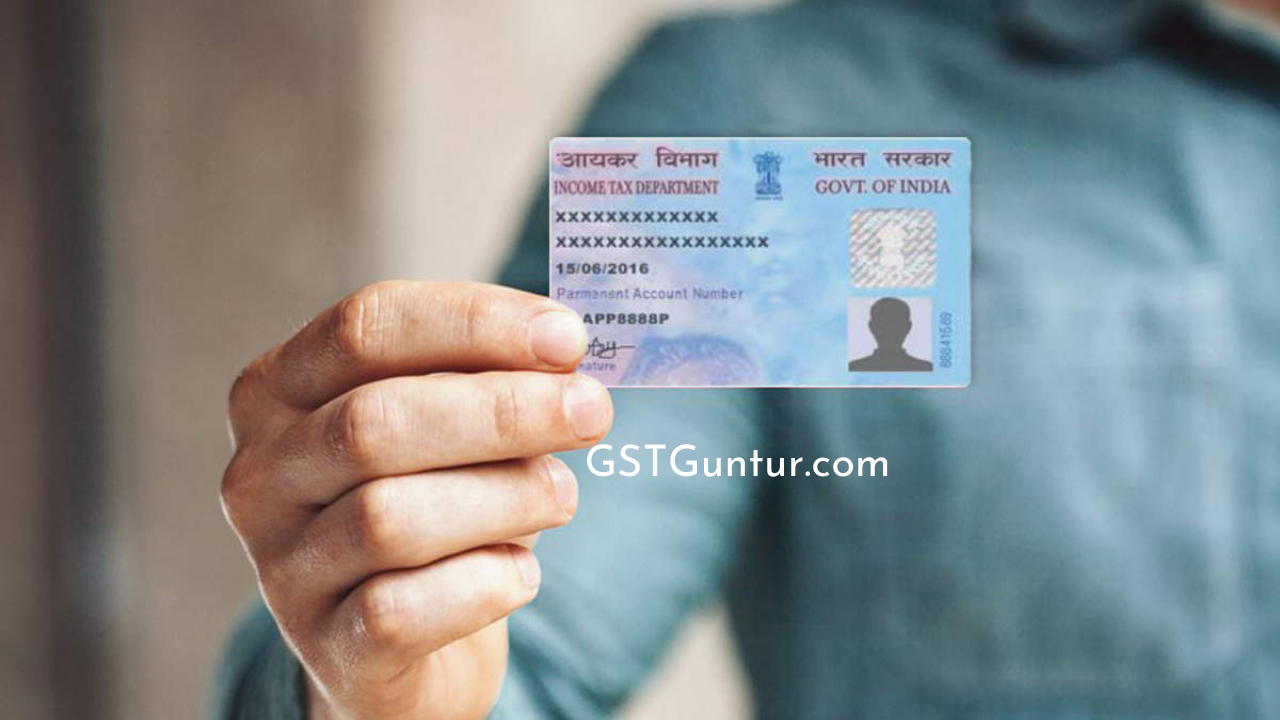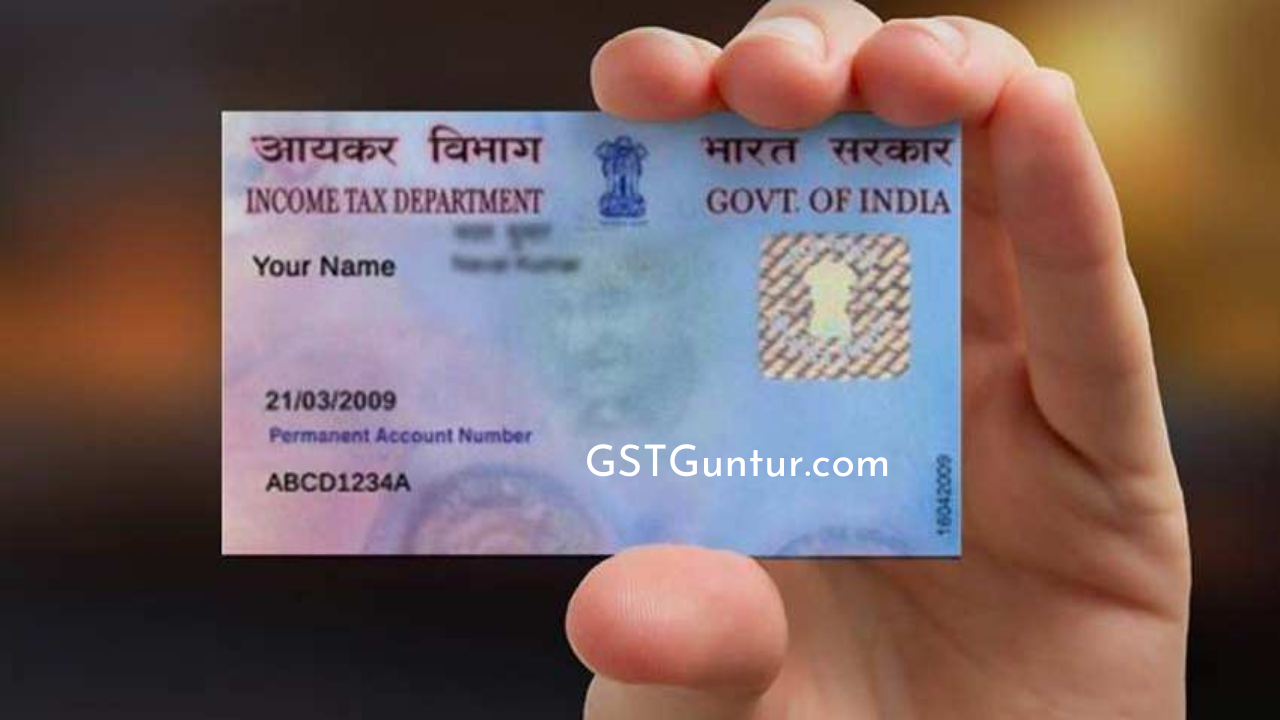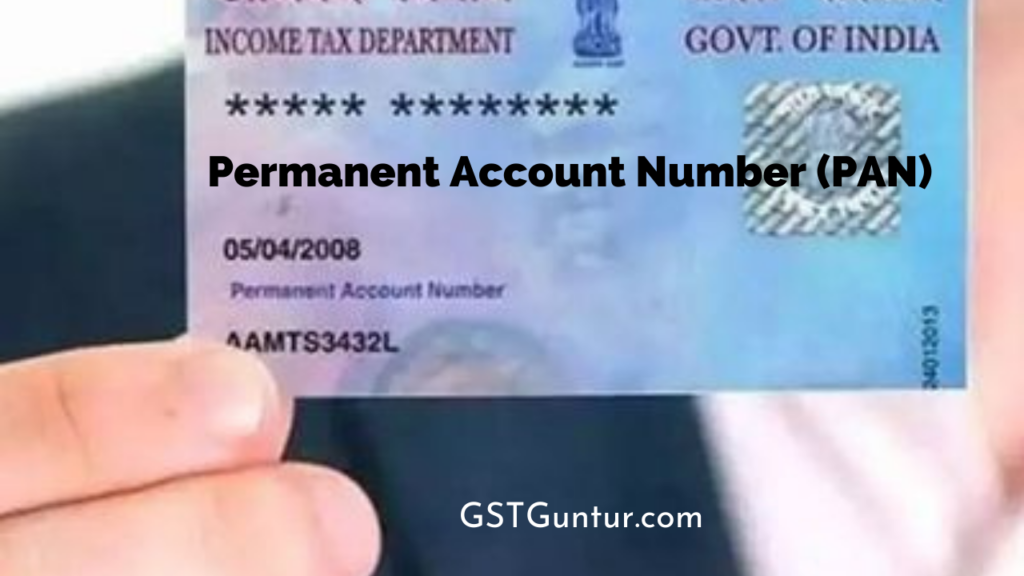Permanent Account Number (PAN): PAN is an electronic system of identification through which all tax-related information for an individual/company is recorded against a single specific PAN number. This acts as the principal key for the storage of information and is distributed and administered across the country. Hence no two tax-paying entities in India can have the same PAN.
A PAN, which basically stands for Permanent Account Number, is a means of identifying multiple taxpayers in the country. PAN is a unique identification 10-digit alphanumeric number (containing both numbers and alphabets) assigned to Indians, mainly to those people who pay tax.
The PAN is simply a system of identification is based on a computer system that assigns a unique identification number to every tax-paying entity in India. All tax-related information for a person is recorded through this program against a single and unique PAN number which acts as the principal key for the storage of information. This is administered across the country, and hence no two individuals on tax paying entities can have the same PAN in India.
PAN Card is given at the time of allotment made to an entity by the Income Tax Department. While PAN is just an alphanumeric number, PAN Card is a physical card that has an individual’s name, date of birth (DoB),
as well as photographs. As proof of DoB or identity, copies of this card can be submitted.
Every individual’s PAN Card is unaffected by any change in address, so it is basically valid for a lifetime.
Overview of PAN or PAN Card
- Name Of Authority issuing PAN– Income Tax Department, Govt. of India
- PAN Customer Care Number– 020 – 27218080
- The inception of PAN Card– 1972
- Validity Of PAN Card– Life Time
- Cost of PAN Card– Rs. 110
- Number Of Enrollments- 25 crores (approximate)
Eligibility for PAN
PAN Card is allotted to individuals, non-resident Indians, companies, or any entities that pay taxes in India.
Types of PAN
- Individual
- HUF-Hindu undivided family
- Company
- Firms/Partnerships
- Foreigners
- Trusts
- Society
Documents Required for PAN
Two types of documents are asked in PAN. Proof of Identity (POI) and Proof of address (POA). Either of the following two documents should meet the criteria.
Individual Applicant– POA/POI – Voter ID, Aadhaar, Driving Licence, Passport
- Hindu Undivided Family– An affidavit of the HUF along with POI/POA details declared by the head of HUF
- Company registered in India– Certificate of Registration published by Registrar of Companies
- Firms/ Partnership (LLP) -Certificate of Registration published by the Registrar of Firms/ Partnership Deed and Limited Liability Partnerships.
- Trust -A copy of the Certificate of Registration Number or Copy of Trust Deed declared by a Charity Commissioner.
- Society -Certificate of Registration Number from Registrar of Charity Commissioner or Co-operative Society
- Foreigners – Passport OCI /PIO card published by the Indian Government Bank statement of the residential country and Copy of NRE bank statement in India

Important Questions Regarding PAN
What is PAN?
PAN is the stands for Permanent Account Number. PAN is basically a unique alphanumeric ten-digit number issued by the Income Tax Department. PAN is most commonly issued in the form of a laminated plastic card (commonly known as a PAN card). Given below is a sample number of PAN: ALWPG5809L
What is the utility of PAN?
In order to link all transactions of the assessee with it, the department gets through PAN. These transactions include tax payments, TCS/TDS credits, specified transactions to a particular organization, returns of income, correspondence, etc. It helps easy retrieval of information of assessee and matching of various borrowings, investments and other activities of the assessee made for business.
What are the Advantages of Getting a Permanent Account Number [PAN] and PAN Card?
A Pan or Permanent Account Number Card has been made mandatory for every transaction with the Income-tax Department. It is also compulsory for numerous other financial transactions such as the opening of bank accounts, a deposit of cash in a bank account, opening of Demat account, dealing in securities, in the bank account, transaction of immovable properties, etc. A PAN card is a relevant median of photo identification accepted by all Government as well as non-Government organizations in the country.
How PAN Gets Its Unique Identity, And How It Is Formed?
PAN is a unique alphanumeric ten-digit number published by the Income Tax Department.
The structure of PAN is presented below:
- Out of the first five characters mentioned in the card, the first three characters represent the alphabetic series covering from AAA to ZZZ. (E.g. ALWPG5809L).
- The status of the PAN holder is represented by the fourth character of PAN represents (E.g. ALWPG5809L).
- “A” – represents Association of Persons (AoP)
- “B” – represents Body of Individuals (BOI)
- “C” – represents Company
- “F” – represents Firm/Limited Liability Partnership
- “G” – represents Government Agency
- “H” – represents Hindu Undivided Family (HUF)
- “J” – represents Artificial Juridical Person
- “L” – represents Local Authority
- “P” – represents Individual
- “T” – represents Trust
- The fifth character of PAN describes the first character of the PAN holder’s surname/last name in the case of a person. In the matter of non-individual PAN holders, the fifth character designs the first character of the PAN holder’s name (E.g. ALWPG5809L)
- The following four characters are sequential numbers running from 0001 to 9999 (E.g. ALWPG5809L).
- The last character, which is the tenth character, is an alphabetic check digit (E.g. ALWPG5809L).
The combination of all the above items provides the PAN with its unique identity.
Who Has To Take Pan?
PAN is to be taken by the following individuals:
- Every individual whose total income or the total income of any other individual in respect of which the person is assessable during the previous year surpasses the maximum amount which is not chargeable to tax.
- A charitable trust who is expected to furnish a return under Section 139(4A)
- Every individual who is carrying on any business or profession whose gross receipts, total sale, or turnover is or is likely to surpass five lakh rupees in any previous year.
- Every individual who intends to enter into specified financial transactions in which quoting of PAN is mandatory.
Every non-individual resident individual and individual associated with them if the financial transaction entered into by such non-individual resident individuals during a financial year exceeds Rs. 2,50,000.
Note: Individuals associated with non-individual resident persons indicates the director, managing director, partner, trustee, author, founder, Karta, chief executive officer, office bearer or principal officer of the non-individual resident persons or any individual competent to act on behalf of such persons.
An individual not incorporated in any of the before-mentioned can voluntarily appeal for PAN.
How to Apply for PAN?
PAN application can be filled up by an individual in the following forms –
- for Indian Citizens- Form 49A
- for Foreign CitizensForm 49AA
PAN application can be filled and applied either online through the website of (www.tin-nsdl.com) or the website of UTIITSL or through any of the NSDL TIN-PAN Centres/ Facilitation Centres.
While submitting the application form of PAN, the applicant will have to indicate whether an E-PAN card or physical PAN card is required.
The physical PAN card must be printed & dispatched at the communication address if an applicant opts for a physical PAN Card.
In case a physical PAN Card is not required, then an email ID will be necessary & an e-PAN Card in the format of PDF will be sent at the provided email ID mentioned in the PAN application form of the PAN applicant. In such cases, a physical PAN Card will not be dispatched.
If an applicant is associated with a company that has not been registered under the Companies Act, 2013, then under sub-section (1) of section 7, Form No. SPICE-INC-32 specified the application for allotment of a Permanent Account Number is to be made for the incorporation of the company. (Application for PAN can also be made through SPICE-INC-32)
Note: w.e.f. 01-07-2017, every individual who is eligible to get an Aadhaar number shall quote either the Aadhaar number or enrolment ID of the Aadhaar application form in the application form PAN.
How to Link the Aadhaar number with PAN Using the e-Filing Portal?
A taxpayer using their registered username and password is asked to log in on the e-Filing portal. After login, the person will get the “link Aadhaar” option under their ‘Profile Settings’.
If the taxpayer’s name and date of birth are identical to Aadhaar and PAN, the Aadhaar number will be linked with PAN.
How to Link the Aadhaar Number with PAN using the SMS Facility?
A taxpayer who wishes to link their Aadhaar number with PAN by using the SMS facility is required to send SMS to 56161 or 567678 in the format given below:
UIDPAN <1 blank space> <12 digit Aadhaar Number> <1 blank space> <10 digit PAN>
SMS to 56161 or 567678:
UIDPAN 222233334444 AAAPA8888Q
Aadhaar number will be automatically linked with PAN if the taxpayer’s name and date of birth are identical to PAN and Aadhaar.
What Are The Particularised Financial Transactions In Which Quoting of PAN is Compulsory?
According to rule 114B, the following are the transactions in which quoting of PAN is mandatory by every individual except the Consular Offices, the State Governments and the Central Government:
- Purchase and sale of a motor vehicle or any vehicle except two-wheeled vehicles.
- Opening an account [other than a Basic Savings Bank Deposit Account and a time-deposit referred at point No. 12] with a cooperative bank or banking company
- Creating an application for the issue of a debit or credit card.
- Opening an account of Demat with a participant, depository, custodian of securities or any other individual with SEBI
- Cash payment of an amount surpassing Rs. 50,000 to a restaurant or hotel against the bill at any one time.
- Payment in cash of an amount surpassing Rs. 50,000 in association with travel to any foreign country or payment for the acquisition of any foreign currency at any one time.
- Payment of an amount to a Mutual Fund surpassing Rs. 50,000 for the acquisition of its units
- Payment of an amount to a company or an institution surpassing Rs. 50,000 for acquiring debentures or bonds published by it.
- Payment of an amount to the Reserve Bank of India surpassing Rs. 50,000 for acquiring bonds published by it.
- Deposit with a co-operative bank or a banking company:-
- Cash surpassing Rs. 50,000 during any one day; or
- Cash deposit of aggregating during the period 09th November 2016 to 30th December 2016 to more than Rs. 2,50,000
- Payment in cash for an amount during any one day surpassing Rs. 50,000 for the purchase of pay orders or banker’s cheques or bank drafts from a banking company or a co-operative bank.
- A time deposit of amount aggregating to more than Rs. 5 lakh or surpassing Rs. 50,000 during a financial year with –
- a co-operative bank or a banking company
- a Post Office;
- a Nidhi assigned to in section 406 of the Companies Act, 2013 or
- a non-banking financial company
- Payment in cash or pay order or banker’s cheque of an amount or by way of a bank draft aggregating to more than Rs. 50,000 in a financial year. Instruments utilized for one or more pre-paid payments, as explained in the policy guidelines for operation and issuance of pre-paid payment instruments issued under section 18 of the Payment and Settlement Systems Act, 2007 of the Reserve Bank of India to a co-operative bank or a banking company or to any other institution or company.
- Payment of an amount total aggregate in a financial year as life insurance premium to an insurer exceeding Rs. 50,000
- A purchase contract or sale of securities(other than shares) for an amount surpassing Rs. 1 lakh per transaction
- Purchase or sale, by any person, of shares of a company not listed in a recognized stock exchange for an amount surpassing Rs. 1 lakh per transaction.
- Purchase or sale as referred to in section 50C of the Act of any immovable property for an amount surpassing Rs. 10 lakh or valued by stamp valuation authority at an amount surpassing ten lakh rupees.
- Purchase or sale of goods or services of any nature other than those particularized above for an amount surpassing Rs. 2 lakh per transaction.
NOTE:
- Minor individuals can quote the PAN of the person’s father or mother, or guardian provided the individual does not have any income liable to income tax.
- Any individual can make a declaration in Form No.60, enters into any of the above transactions if the person does not have PAN.
- Quoting of PAN is not needed by a non-resident in a transaction mentioned the before mentioned point.

How Does The Department Of Income Tax Guarantee That PAN Is Quoted On Transactions In Which Quoting Of Pan Is Mandatory?
It is a statutory responsibility of an individual receiving a document relating to financial or economic transactions declared by the Central Board of Direct Taxes (CBDT) to assure that PAN has been appropriately quoted in the documents quoting of PAN compulsory. Thus, the recipient of these documents will guarantee that PAN is mentioned in the respective document. E.g. PAN is mandatory to open a bank account, and hence the Bank will assure that the applicant has quoted their PAN at the moment of applying for a bank account.
Can One File Their Return Of Income Without Quoting PAN?
It is compulsory to quote PAN on the return of income of an individual. PAN is also quoted in all challans apart from the return of income for making payment of tax, agreement with the Income Tax Department, etc.
However, w.e.f., 01-09-2019, as per section 139AA, every individual who has been allotted a PAN and who has linked their Aadhaar number with PAN may furnish their Aadhaar number instead of a PAN for all the transactions where quoting of PAN is compulsory as per Income-tax Act. Thus, an assessee can file his return of income with effect from September 1, 2019, by quoting their Aadhaar number instead of mentioning their PAN.
How to Link The Aadhaar Number with PAN?
By utilising either of the two ways, any individual can link the Aadhaar’s number with PAN :
- Using SMS facility
- Using the facility portal on e-Filing.
For Obtaining the PAN, Does The Applicant Are Required To Pay Any Charges?
The applicants are required to pay a fee of Rs. 93 + GST as applicable, per PAN application. In case the PAN card is needed to be dispatched outside India, then the processing charge for PAN application is Rs. 864/- (application fees- Rs. 93 and dispatch charges-Rs. 771) will be required to be paid by the applicant. (additional GST also applicable).
Can An Individual Opt For A TATKAL Facility, If There Any For Allotment Of PAN?
No, since there is no such facility mentioned, any individual can not opt for a TATKAL facility for the allotment of PAN.
In Form 49A/49AA, what Information and Documents must be presented along with the PAN application?
As specified in Rule 114 of the Income-tax Rules, the documents must be submitted with the PAN application. The application form also includes and necessitates all the required details of the documents. Individual applicants have to produce documents pertaining to proof of identity, proof of date of birth and proof of address. The name appearing in the documents submitted of the applicant and the name as mentioned in the application form should match precisely along with the application.
Individual applicants should attach two recent colour photographs of size 3.5 cm x 2.5 cm with white background in the space as required and mentioned on the form. The photographs should not be clipped or stapled to the form. The image clarity on the PAN card will entirely depend on the clarity and quality of the submitted photograph affixed on the form.
If an Applicant Comes under Individual/HUF (Hindu Undivided Family), what Documents will Serve as Proof of Identity?
In the case of individual applicants being citizens of India, any of the following documents will work as proof of identity (including those located outside India):
Copy of following
- Aadhaar Card issued by India’s Unique Identification Authority; or
- Elector’s photo identity card of the applicant; or
- Driving License of the applicant; or
- Passport of the applicant; or
- Applicant’s ration card having a photograph; or
- Arm’s license; or
- Photo identity card issued by the Public Sector Undertaking or State Government or Central Government; or
- Pensioner card of the applicant with an attached photograph of the person; or
- Central Government Ex-Servicemen Contributory Health Scheme photo card or Health Service Scheme Card
- Identity certificate in original signed by a Gazetted Officer or a Municipal Councilor, as the case may be Member of Parliament or Member of Legislative Assembly; or
- Bank certificate containing bank account number and duly attested original photograph of the applicant on letterhead from the branch (along with the issuing officer’s name and stamp).
For HUF, an affidavit was made by stating the name of the Karta of Hindu Undivided Family, name of the father and address of all the coparceners on the application date and a copy of any of the before-mentioned documents in the name of Karta of HUF is needed as proof of identity.
In the case of Minor, any of the before mentioned documents of any of guardians/parents of such minor shall be considered to be the appropriate proof of identity for the minor applicant.
What Documents Will Be Considered As Address Proof In The Case Of Individual/HUF Applicants?
Copy of any of the following documents will serve as proof of address in case of individual applicants being citizens of India (including those located outside India) :
Copy of following:
- Aadhaar Card publish by the Unique Identification Authority of India; or
- Elector’s photo identity card; or
- Driving License; or
- Passport; or
- Passport of the spouse; or
- Post office passbook having the applicant’s address; or
- Latest property tax assessment order; or
- Domicile certificate; or
- Allotment letter of accommodation not being more than 3 years old issued by Central or State Government; or
- Document of Property Registration; or
Copy of following documents of not being older than three months
- Electricity Bill; or
- Landline Telephone or Broadband connection bill; or
- Water Bill; or
- Consumer gas connection card or the book or piped gas bill; or
- Bank account statement; or
- Depository account statement; or
- Statement of the Credit Card; or
Note: In the case of an Indian citizen residing outside India, a copy of Non-resident External (NRE) bank account statements or a copy of Bank Account Statement in the country of residence (not older than three months) shall be address proof.
- Original identity certificate duly signed by an MP or MLA or Municipal Councilor or a Gazetted officer, as the case may be.
- Employer certificate in original.
For HUF, an affidavit issued by the Karta of HUF stating the name, name of the father and address of all the coparceners on the application date and a copy of documents mentioned above in the name of Karta of HUF is required as proof of address.
In the case of Minor, any of the documents as mentioned above of any of the parents/guardians of such minor shall be considered to be the relevant address proof for the minor applicant.
Can An Application On Plain Paper Be Considered for PAN?
Application for PAN is not allowed to be made on a plain sheet of paper. The application for PAN must be made in the prescribed form, i.e. Form No. 49A as the case may be Form No. 49AA. Form No. 49A, as per the ITR Act, is meant to be used by Indian citizens/Entities incorporated in India/Unincorporated entities/Indian Companies formed in India and Form No. 49AA is intended to be used by a person who is not a citizen of India/Incorporated entities created outside India/Entities unincorporated outside India).
In case the applicant is a company or being associated with it, which has not been registered under the Companies Act, 2013, then as specified under sub-section (1) of section 7 of the ITR Act for incorporation of the company, the application for Permanent Account Number allotment is to be made in SPICE-INC-32.
In Form 49A/49AA, What Shall Happen If An Individual Submits An Incomplete PAN Application?
TIN Facilitation Centers or IT PAN Service Centers shall not receive any deficient and incomplete PAN application. However, an individual can ask help from these centres, and they will assist applicants to fill up form 49A/49AA (as the case may be) correctly.
Is It Mandatory To Fill The Pan Application Form (i.e. Form 49A/49AA) in Block Letters?
Yes, it is necessary to fill the PAN application form [like Form 49A/49AA (as the case may be)] to be filled legibly in BLOCK LETTERS and preferably in black ink. It should also be noted that each box, wherever provided, should carry only one character (number/punctuation sign/ alphabet), leaving a blank box after every word.
In The Case Of Individual Applicants, What Documents Will Serve As Proof Of Date Of Birth?
Copy of any of the following documents will be considered as the proof of date of birth in the case of individual applicants being Indian citizens (including those located outside India):
- Birth Certificate issued by any office authorized or the Municipal Authority to issue Birth and Death Certificate by the Indian Consulate or the Registrar of Birth and Death as defined in clause (d) of sub-section (1) under section 2 of the Citizenship Act, 1955 (57 of 1955); or
- Order of pension payment; or
- Certificate of Marriage issued by Registrar of Marriages; or
- Certificate of Matriculation; or
- Passport; or
- Driving License; or
- The Government’s issued Domicile Certificate; or
- Affidavit stating the birth date which is sworn before a magistrate
In The Case Of An Applicant Other Than Individual/HUF, What Documents Are Required To Be Submitted?
In the case of an applicant other than individual/HUF, the following documents are required to be submitted along with the PAN application:
- Partnership Firm registered or formed in India- Copy of partnership deed or Copy of the Registrar of Firms issued Certificate of Registration.
- Limited Liability Partnership registered or formed in India- Copy of the Registrar of LLPs issued Certificate of Registration
- Association of Persons (Trust) registered or formed in India- Copy of Charity Commissioner issued trust copy or deed of certificate of the registration number.
- Association of Person(other than trusts), Local Authority, Body of Individuals, or Artificial Juridical Person registered or formed in India- Copy of Agreement or copy of the certificate of registration number issued by the registrar of co-operative society or any other competent authority or charity commissioner or any other document originating from any department of State or Central Government establishing address and identity of such individual.
In the Case Of Individuals Who Are Not Citizens Of India, What Documents Will Serve As Proof Of Identity?
Copy of following will serve as identity proof in case of individuals not being a citizen of India :
- Passport copy, or
- Copy of Government of India’s issued Person of Indian Origin (PIO) card, or
- Copy of Government of India’s issued Overseas Citizen of India (OCI) card, or
- Copy of other national or citizenship Taxpayer Identification or Identification Number
Number duly attested by “Apostille” (in respect to the countries which are signatories to the Hague Apostille Convention of 1961) or by the High Commission or Consulate in the country or Indian Embassy where the applicant is authorised or located officials of overseas branches of Scheduled Banks registered in India.
Can One Application On Behalf Of The Non-Resident, Idiot, Court Of Wards, Minor, Lunatic?
A non-resident, idiot, mentally retarded, deceased, wards of court, minor, lunatic, and such other persons as stated in Section 160 of Income-tax Act, 1961 can be represented through a Representative Assessee.
In such a situation,
- Details of the minor, non-resident, lunatic, idiot, mentally retarded, wards of court, deceased etc., should be provided in the application for PAN.
- In item 14 of the PAN application, details of the representative assessee have to be provided.
Address Proof and Proof of Identity is also needed for the representative assessee.
In Form 49A/49AA, Who Has To Sign The PAN Application?
In Form 49A/49AA, the application form must be signed (in case of persons unable to sign-left thumb impression) by :
- The applicant; or
- In the case of HUF- Karta; or
- Company Director; or
- Authorised Signature in case of Association of Persons, Local Authority, Artificial Juridical Person and Body of Individuals; or
- In case of Firm/LLP- Partner; or
- Trustee; or
In case of Mentally-retarded/minor/deceased/idiot/lunatic/, by a Representative Assessee.
In Form 49A/49AA, What Is The Process Of Signing The PAN application?
The applicant has to attach a signature at three places in form 49A/49AA. If the applicant cannot sign the form, then at the place meant for signatures, the applicant’s Left-Hand Thumb impression should be affixed and attested by a Gazetted Officer, a Magistrate, or a Notary Public under official stamp and seal. Three places where signature/thumb impressing are required as follows:
- One left-hand thumb impression/signature should be given across the photo affixed on the left side of the form in such a way that a portion of the signature or the thumb impression is on the form as well as on the photo.
- On the right side of the form, one left-hand impression/signature impression should be made within the box provided. The signature or the thumb impression should not be on the affixed photograph on the right side of the form.
- At the end of the form, another left-hand thumb impression/signature impression should be provided. Within the box provided for signature /left-hand thumb should be.
Applications are liable to be rejected if not signed in the given manner and the space provided for signature.
In The Circumstances Of Individuals Not Being Citizens Of India, What Documents Will Be Considered As Address Proof?
In case of people who are not a citizen of India, copy of the following will serve as proof of address:
- Copy of passport, or
- Copy of Government of India’s issued Person of Indian Origin (PIO) card, or
- Copy of Government of India’s issued Overseas Citizen of India (OCI) card, or
- Copy of other national or citizenship Taxpayer Identification or Identification Number
Number duly attested by “Apostille” (in respect to the countries which are signatories to the Hague Apostille Convention of 1961) or by the High Commission or Consulate in the country or Indian Embassy where the applicant is authorised or located officials of overseas branches of Scheduled Banks registered in India.
- Copy of the Applicant’s Statement of Bank account in the country of residence, or
- Copy of the Applicant’s Non-resident External (NRE) bank account statement in India, or
- Copy of the Applicant’s Certificate of Residence in India or Residential permitted by the State Police Authorities, or
- Copy of the Applicant’s Registration certificate published by the Foreigner’s Registration Office showing Indian address, or
- Copy of the Applicant’s Visa granted & appointment letter or the employer’s issued contract from Indian Company & Certificate (original) of Indian address.
If Applicants Are Unincorporated Entities Formed Outside India/Entities Incorporated Outside India, What Documents Will Serve As The Relevant Proofs?
In case of applicant being Unincorporated entities formed outside India/entities incorporated outside India, a copy of the following will serve as relevant proof:
Certificate of Registration authorised by the country where the applicant is located, where the number must be duly attested by “Apostille” (in respect of countries which are signatories to the Hague Apostille Convention of 1961) or by the High Commission or Consulate in the country or Indian Embassy where the applicant is authorised or located officials of overseas branches of Scheduled Banks registered in India.
Copy of approval granted to set up an office in India or of registration certificate issued in India by Indian Authorities.
In Form 49A/49AA, is it Compulsory To Provide the Assessing Officer Code?
The applicants need to compulsorily fill up and produce the Assessing Officer (AO) Code in Form 49A/49AA. AO Code (i.e. Range Code, AO Number and Area Code, AO Type) of the Jurisdictional Assessing Officer. These details can be obtained from the PAN Centre or websites of PAN service providers or the Income Tax Office.
Does It Necessary To Provide A Father’s Name For A Married Female?
Applicants should provide their father’s name while providing the full name, and hence, the married female should also provide their father’s name and not their husband’s name.
How Can One Check The Status Of The Individual’s PAN Application after making the PAN application?
After applying for PAN, an individual can check the status of their application by using the track status facility available at websites of the UTIITSL or NSDL or Income Tax Department.
After Getting PAN, Is It Necessary To File a Return of Income?
According to the statement mentioned under section 139, a return is must be filed only if the individual is liable to file a return of income.
It is not mandatory to file a return of income after getting PAN.
Should a Person Intimate Their PAN to the Deductor With Regards To Person Deducting Tax?
Yes, one should intimate their PAN to the deductor with regards to the person deducting tax. Non-furnishing of PAN to deductors charged from 1st April 2010 results in TDS at a much steeper rate of 20% or even more.
Can Any Person Hold More Than One PAN?
Any individual cannot hold more than one PAN. If a PAN is allotted to an individual, then the person cannot apply for obtaining another PAN. Under The Income-tax Act, 1961 of Section 272B, a fine of 10,000/- is liable to be imposed for possessing more than one PAN.
If an individual has been allotted more than one PAN, then the person should immediately surrender the additional PAN card(s).
If, By Mistake, An Individual Has Been Using Different PANs for Different Purposes, Like One For Filing My IT Return and tax payment and another for a Demat account, then how can one resolve such a problem?
According to Income Tax Act, it is advisable to hold only one PAN, preferably the one used for purposes of Income-tax and should immediately surrender the other number. The financial institutions where the latter PAN number has been quoted should be informed of the correct PAN.
In Case of Issues Relating to PAN, Whom To Contact?
One should contact NSDL in case of PAN card is not received by the applicant.
The NSDL or Income Tax Department in any of the following means can be contacted.
What is the Validity Of A Person’s PAN?
PAN is valid for the lifetime once obtained by the PAN holder throughout India. The change of address or the accessing officer does not affect PAN. However, by providing the details in the form for “Changes or Correction in PAN Data Or/ And Request For New PAN Card”, any type of change can be made in the database of the PAN (i.e. details provided at the time of obtaining PAN), which should be intimated to the Income Tax Department.
How Can An Individual Apply for PAN Correction?
By providing the details in the form for “Changes or Correction in PAN Data Or/ And Request For New PAN Card”, any type of change can be made in the database of the PAN(i.e. details provided at the time of obtaining PAN), which should be intimated to the Income Tax Department both online or offline mode.
- For offline mode, at the nearest PAN facilitation centre, all people are required to submit the “Changes or Correction in PAN Data Or/ And Request For New PAN Card” form.
- For online mode, one needs to visit through the online portal of NSDL and opt for the “Changes or Correction in PAN Data Or/ And Request For New PAN Card” option.
What is the Penalty Charged On A Person for not Complying With The Provisions Relating to PAN?
In case of any default by the taxpayer in complying with the provisions relating to PAN, then as per Section 272B, a penalty will be charged to the taxpayer for the following issues:
- a person not obtaining PAN, even though the individual is liable to get PAN, or
- a person in any prescribed document intentionally quoting incorrect PAN in which PAN is to be quoted or
- a person is intimating incorrect PAN to the individual deducing tax or individual collecting tax.
As mentioned, under section 272B, the penalty amount that will be charged to the taxpayer will be Rs. 10,000, which under the provisions of section 139A, can be levied for failure to comply with and for failure to Quote or to Quote invalid PAN, a penalty of Rs. 10000 per default shall be levied.
How to Get The Area Code For My Area for the PAN Allotment?
It is mandatory to provide the area Code while applying for TAN and PAN. The applicant must fill up the area Code (i.e., Area Code, AO Type, Range Code, AO Number) of the Jurisdictional Assessing Officer. These details can be obtained from the official site of NSDL.
What is E-PAN?
The PAN provided in PDF format rather than a physical card is known as E-PAN. The E-PAN card in the format of PDF will be sent to the e-mail ID specified in the application form of PAN. The PAN applicant will have to designate when submitting the PAN application if the physical PAN Card is not required. In such circumstances, an Email ID will be compulsory & E-PAN Card will be provided to the PAN applicant at their specified email ID, and in such cases, a physical PAN Card will not be dispatched. For an E-PAN card, the charges are different from a physical PAN card.
What is PAN verification?
As per the database of the Income Tax Department, the PAN verification functionality helps the deductor in verifying whether the provided PAN by the deductee (Tax Payer) is valid.
What outcomes are faced by an individual for Not linking PAN with Aadhaar Numbers?
The Central Board of Direct Taxes has notified Rule 114AAA prescribing the manner and consequences if PAN becomes inoperative. The Rule 114AAA(2) presents that where an individual, whose PAN has become inoperative, it shall be deemed that the person has not quoted furnished, or intimated the PAN, as the situation may be, and under the Act, the individual shall be liable for all the consequences for not quoting, furnishing or intimating the PAN.
However, the individual can reactivate their PAN by subsequently intimating their Aadhaar to the department.
What is the Operation Model of PAN?
The issuance of PAN, verification, maintenance works, and delivery on the PPP- public-private partnership models like PSK- Passport Seva Kendra for reasons of efficiency, effectiveness, and economy.
The reputed entities like UTI Infrastructure Technology Services Limited (UTIITSL) and NSDL e-Governance Infrastructure Limited (formerly National Securities Depository Limited) have been consigned by Income Tax Department as instructed service providers for the processing of applications, handling, verifying, and collecting personal documents like age, address, proof of ID, clarification with the applicants, printing the letter and the card and then mailing it.
After the successful processing of the application documents, such processing agencies obtain the new PAN number online from the server of the iT department. Some authorities in India may command the processing, handling, and delivery of financial documents as well as personal ID by private contractors or for a violation of privacy.
On the official TIN website, the e-Gov centres of NSDL can be located. By using Aadhaar based eSignature, it has now become very easy for online applications at NSDL e-Gov’s website. An individual can register themselves first at e-Gov’s website of NSDL.
The applicant receives a token number after registration. Any individual can continue with filling form. The applicant will be able to save the details and complete the form at their convenience by logging in using their registered details. One can upload signature/photo and supporting documents and, using Aadhaar and OTP, can finally eSign the application.
People can download and keep a copy of the signed form after successful e-Sign, for their reference. An acknowledgement form and receipt are also received through e-mail at registered e-mail ID.
On the official website of UTIITSL, centres can be located.
What are Outcomes for Not linking PAN with Aadhaar Number
The manner and consequences are prescribed by the Central Board of Direct Taxes have notified Rule 114AAA if PAN becomes inoperative.
The Rule 114AAA(2) presents that where an individual, whose PAN has become inoperative, it shall be deemed that the person has not quoted furnished, or intimated the PAN, as the situation may be, and under the Act, the individual shall be liable for all the consequences for not quoting, furnishing or intimating the PAN.
However, the individual can reactivate their PAN by subsequently intimating their Aadhaar to the department.
Further, if an individual fails to link PAN-Aadhaar by the due date, then under section 234H, the individual shall have to pay a fee, maximum of Rs. 1,000. This fee due to the non-intimation of Aadhaar shall be an extension to the other consequences the individual has to face if PAN becomes inoperative.
What is Instant-PAN?
New functionality has been launched by the Income-tax Dept. on the e-filing portal, which permits a PAN to the assessee based on their Aadhaar Number.
This facility can be practised by an assessee only if the following requirements are satisfied:
- The person has never been allotted a PAN;
- The person’s mobile number is linked with his Aadhaar number;
- The person’s complete date of birth is available on the Aadhaar card; and
- The person on the date of application for PAN should not be a minor.
How to Get Instant PAN Using the Instant-PAN Functionality?
- Visiting the official site and tapping on the link ‘Instant PAN’ through Aadhaar’ addressed on the right-hand side
- Click on ‘Get New PAN.’
- Enter the Applicant’s Aadhaar Number
- Enter the OTP obtained on the mobile number linked with the Aadhaar Number.
- Validate the Details of Aadhaar
- Validate Email-id
- Finally, Download the e-PAN











